Agostino Brunias
Agostino Brunias (1730 – 2 April 1796) was an Italian painter from Rome. He left London at the height of a career decorating building projects under the prominent neoclassicist Robert Adam in order to chronicle the British West Indies, particularly Dominica and neighboring islands in the Lesser Antilles. He is best known for his Caribbean works, completed between 1764 and his death in 1796.

Career
Brunias was born in Rome c. 1730;[1] the exact date is uncertain. His first name has been spelled in various ways including Abraham, Alexander, August, or Austin, while his surname has been recorded as Brunais and Brunyas.[2]
Brunias was a student at the Accademia di San Luca, Rome. In 1752, he exhibited an oil painting,[3] and in 1754 he won Third Prize in the Second Class for painting.[4]
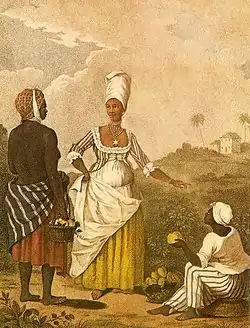
Brunias met the prominent Scottish architect Robert Adam, who was on a Grand Tour studying the "magnificent ruins of Italy" between 1754 and 1756. Adams employed Brunias in his workshop in Rome, and Brunias accompanied Adams on his return to England in 1758.
Brunias worked as a draughtman and painter on many of Adam's building projects in Britain. Adam, praising his works, called Brunias a "bred painter". His murals and paintings covered the interior walls of many stately homes.[1][2][3] Surviving examples of Brunias' early work include five paintings in the classical style (1759-1760), which were commissioned to decorate the breakfast room at Kedleston Hall, now housed at the Victoria and Albert Museum.[5] By 1762, Brunias was residing in Broad Street, Carnaby Market, London[3] and in 1763 and 1764, he exhibited at the Free Society of Artists in London.[2]
At the end of 1764, Brunias left London for the British West Indies under the employ of Sir William Young, 1st Baronet. Young was at that time newly-appointed "President of the Commission for the Sale of Ceded Lands in Dominica, Saint Vincent, Grenada and Tobago", following the Treaty of Paris, where the French had ceded the territories in the Lesser Antilles to the British. Then in 1768 Sir William Young was appointed Lieutenant Governor of Dominica, and in 1770 Young was appointed Governor of Dominica. Brunias accompanied Young on his travels through the West Indies. The opportunity provided him with subject matter including indigenous Carib life and evolving 18th-century creole cultures. His first sketches of the West Indies were done in Bridgetown in 1765, one of which was turned into a popular engraving titled "Barbados Mulatto Girl." Following Sir William Young, Brunias settled in settled in Dominica's capital, Roseau.[1] From the West Indies, Brunias submitted two drawings to the Society of Artists' exhibition of 1770 in London.[2][6] Governor Young remained Brunias' primary patron until 1773, when he returned home to England.
Brunias completed many sketches, watercolors, and oil paintings in the Carribbean. Like many artists working in the Americas, Brunias returned to England around 1775 in order to promote and sell his growing collection of work. In 1777 and 1779, three of his West Indian paintings were shown at the Royal Academy.[7] He followed this accomplishment by publishing engravings of his West Indian paintings, some of which were "by his own hand".[6][7][2] During this time he also created wall paintings of "Caribbean aborigines" for the antelibrary at Stowe House.[1]
During Brunias' absence from the West Indies, Dominica and St. Vincent were occupied by the French; Britain did not regain the colonies until the Treaty of Versailles was signed in 1783. Brunias was finally able to return to Dominica in 1784, and remained there until his death on the island of Dominica in 1796.[1] He returned to Dominica and St. Vincent with commissions, including one for a set of botanical drawings from Alexander Anderson, Curator of the Botanic Gardens of St. Vincent. [1]
During the Haitian Revolution in the 1790s, Toussaint Louverture, liberator of Haiti and one of Brunias' supporters, wore eighteen buttons on his waistcoat which were each decorated with a different hand-painted miniature reproduction of Brunias' West Indian scenes.[8][9]
Engravings of his designs continued to be published posthumously. Harvard University's Fogg Museum, Yale Center for British Art and Tate (London) own examples of his works.[2] His work has also been acquired by the Victoria and Albert Museum,[10] Cooper Hewitt, Smithsonian Design Museum,[11] and The Brooklyn Museum.[12]
Artistic Style and Interpretations
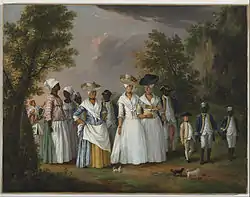
Brunias in his collected works is shown to be predominantly a figure painter, with strong classical influences. His association with Robert Adams in the 1760s places Brunias firmly within the early neoclassical, or first classic revival, movement in Britain. Although he occasionally painted landscapes and other subject matter, classically-influenced figures are the most common feature in his early work as well as in his later West Indian pieces.[13]
In 1808, artist and critic Edward Edwards summarized Brunias body of work as consisting of "decorative subjects for panels and ceilings, both in colours and chiaroscuro," and of West Indian subject matter.[6]
His paintings of Dominica, St. Vincent, St. Kitts, and Barbados provide a valuable insight into life on these islands during the colonial period. His works depicts the influence of the diverse European, Caribbean, and African cultures prevalent in the 18th century Caribbean. He was particularly adept at documenting 'Negro festivals', dances, markets, and other related cultural traditions, as well as showing interaction between indigenous Caribs and colonial settlers. Brunias' sketches and paintings of Caribs are of particular note as they depict the disappearing native culture on the islands.[8][12] Brunias has also been noted by dress historians for his varied and diverse depictions of 18th-century Caribbean clothing.[1]
Although Brunias was mainly commissioned to depict the plantation life of the white elite in his first years in the Caribbean, especially by his major patron Sir William Young, his works assumed a subversive political role in the Caribbean. To many, Brunias' depictions of Caribbean life appeared to be endorsing a free, anti-slavery society, and exposing the artificiality of racial hierarchies in the West Indies. For example, Free Women of Color with their Children and Servants in a Landscape (c. 1764–96), an oil painting on canvas, depicts colonial men and women of color as privileged and prosperous. Toussaint Louverture was also a patron of Brunias' work during the Haitian Revolution, revealing that Caribbean people themselves connected with Brunias' depictions.[8] [12]
At the same time, several critics have argued that Brunias' images of communities of color romanticized and obscured the harsh realities of colonialism and slavery.[13][3] This criticism is supported by the use of Brunias' engravings in historian and politician Bryan Edwards' History of the British Colonies in the West Indies. Bryan Edwards was a staunch defender of slavery, and interpreted the Brunias engravings to support his argument that enslavement was a happy and humane condition.[1]
Personal life
Born in Italy and achieving success in England, Agostino Brunias spent more than twenty-five years in the Caribbean, where he primarily resided in Dominica. He is also known to have lived in St. Vincent, and he spent time on Barbados, Grenada, St. Kitts, and Tobago.
He started a family in Rouseau, Dominica around 1774, shortly before he returned to England, and was then separated from them by war. From church records it seems that his children's mother was a "free mulatto woman" and that they had at least two children. After being reunited with his family after nearly ten years, he remained with them in Roseau until his death.[1] Several historians have suggested that Brunias' identity as Italian Catholic made him sympathetic to the diverse, creolized Catholic community that had formed under French colonialism before 1763, and somewhat alienated him from the Protestant society of the British colonialists.[1] <[14]
He died on 2 April 1796 at the age of 66, and was buried in the Catholic cemetery on the site of the present-day Roseau Cathedral.[3]
Gallery
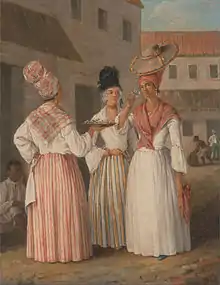 A West Indian Flower Girl and Two other Free Women of Color ca. 1769[15]
A West Indian Flower Girl and Two other Free Women of Color ca. 1769[15] A Mother with her Son and a Pony ca. 1775[16]
A Mother with her Son and a Pony ca. 1775[16] A Family of Carib natives drawn from life ca. 1765 - 1770s
A Family of Carib natives drawn from life ca. 1765 - 1770s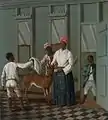 Servants washing a deer ca. 1775[17]
Servants washing a deer ca. 1775[17] View on the River Roseau, Dominica c. 1770-1780[18]
View on the River Roseau, Dominica c. 1770-1780[18]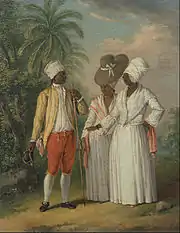 Free West Indians of Dominica ca. 1770[19]
Free West Indians of Dominica ca. 1770[19] Lithograph. Cudgelling Match between English and French Negroes in the Island of Dominica. Published 1779.[20]
Lithograph. Cudgelling Match between English and French Negroes in the Island of Dominica. Published 1779.[20]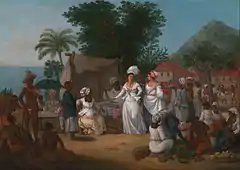 A Linen Market with a Linen-stall and Vegetable Seller in the West Indies ca. 1780[21]
A Linen Market with a Linen-stall and Vegetable Seller in the West Indies ca. 1780[21]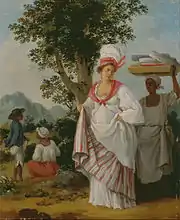 West Indian Creole woman, with her Black Servant ca. 1780[22]
West Indian Creole woman, with her Black Servant ca. 1780[22] Free Women of Color with their Children and Servants in a Landscape
Free Women of Color with their Children and Servants in a Landscape Market Day, Roseau, Dominica[23]
Market Day, Roseau, Dominica[23] West Indian Women of Color, with a Child and Black Servant ca. 1780
West Indian Women of Color, with a Child and Black Servant ca. 1780 Free West Indian Creoles in Elegant Dress ca. 1780[24]
Free West Indian Creoles in Elegant Dress ca. 1780[24] West Indian Man of Color, Directing Two Carib Women with a Child ca. 1780[25]
West Indian Man of Color, Directing Two Carib Women with a Child ca. 1780[25] Planter and his Wife, with a Servant ca. 1780
Planter and his Wife, with a Servant ca. 1780 Linen Market in Dominica ca. 1780[26]
Linen Market in Dominica ca. 1780[26] West Indian Scene ca. 1795, miniature painting on a button. Owned by Toussaint L'Ouverture.[27]
West Indian Scene ca. 1795, miniature painting on a button. Owned by Toussaint L'Ouverture.[27] Etching titled A Negro Festival drawn from Nature in the Island of St Vincent/from an original in the collection of Wm. Young[28]
Etching titled A Negro Festival drawn from Nature in the Island of St Vincent/from an original in the collection of Wm. Young[28].jpg.webp) Chatoyer the Chief of the Black Charaibes in St. Vincent with his five Wives. Engraving by Charles Grignion published 1796 after original art by Agosto Brunias.[29]
Chatoyer the Chief of the Black Charaibes in St. Vincent with his five Wives. Engraving by Charles Grignion published 1796 after original art by Agosto Brunias.[29] The linen market at Saint-Domingue. Engraving published 1804.
The linen market at Saint-Domingue. Engraving published 1804.
References
- Honychurch, Lennox (October 10, 2003). "Chatoyer's Artist: Agostino Brunias and the depiction of St Vincent". Cave Hill, Barbados: The University of the West Indies. Archived from the original on December 15, 2012. Retrieved 25 June 2011.
- Sutton, Peter C. "Agostino Brunias c. 1730 – Dominica, c. 1796". Madrid, Spain: Museo Thyssen-Bornemisza. Archived from the original on 10 June 2011. Retrieved 23 June 2011.
- Meeks, Brian; Lindahl, Folke (2001). New Caribbean thought: a reader. University of the West Indies Press. pp. 250–. ISBN 978-976-640-103-0. Retrieved 23 June 2011.
- Fleming, John (1962). Robert Adam and his circle, in Edinburgh & Rome. Harvard University Press. p. 360. Retrieved 23 June 2011.
- Brunias, Agostino (1759–1760). "Decorative painting for Kedleston Hall". Victoria and Albert Museum Collections. Retrieved 25 August 2020.
- Edwards, Edward (1808). ""Augustine Brunias"". Anecdotes of painters who have resided or been born in England; with critical remarks on their productions. London: Leigh and Sotheby. p. 65-66.
- Nussbaum, Felicity A (13 July 2005). The Global Eighteenth Century. JHU Press. pp. 351–. ISBN 978-0-8018-8269-2. Retrieved 24 June 2011.
- "Brooklyn Museum Acquires 18th Century Painting by Agostino Brunias Depicting Colonial Elite". Art Daily. Brooklyn, New York. Retrieved 17 August 2020.
- Geracimos, Anne (January 2000). "A Mystery in Miniature: An enigmatic button once decorated the uniform of Haitian liberator Toussaint Louverture". Smithsonian Magazine. Retrieved 25 August 2020.
- http://collections.vam.ac.uk/search/?listing_type=&offset=0&limit=15&narrow=&extrasearch=&q=brunias&commit=Search&quality=0&objectnamesearch=&placesearch=&after=&before=&namesearch=&materialsearch=&mnsearch=&locationsearch=
- https://collection.cooperhewitt.org/people/18537399/
- https://www.brooklynmuseum.org/opencollection/objects/197252
- Bagneris, Mia L. "Project Description Local Colors: Interracial Sexuality and the Mixed-Race Body in the Caribbean Canvases of Agostino Brunias". Cambridge, Massachusetts: WEB du Bois Institute for African and African American Research, Harvard University. Archived from the original on 30 April 2011. Retrieved 25 June 2011.
- Bagneris, Mia (2017). Colouring the Caribbean: Race and the art of Agostino Brunias. Manchester: Manchester University Press.
- http://collections.britishart.yale.edu/vufind/Record/1670107
- http://collections.britishart.yale.edu/vufind/Record/1669688
- http://collections.britishart.yale.edu/vufind/Record/1669689
- https://www.artic.edu/artworks/79037/view-on-the-river-roseau-dominica
- http://collections.britishart.yale.edu/vufind/Record/1670101
- https://jcb.lunaimaging.com/luna/servlet/s/5r8m27
- http://collections.britishart.yale.edu/vufind/Record/1669690
- http://collections.britishart.yale.edu/vufind/Record/1670163
- "Market Day, Roseau, Dominica". Yale Center for British Art, Paul Mellon Collection. Retrieved 25 August 2020.
- http://collections.britishart.yale.edu/vufind/Record/1670148
- http://collections.britishart.yale.edu/vufind/Record/1670150
- http://collections.britishart.yale.edu/vufind/Record/1670119
- Cooper Hewitt, Smithsonian Design Museum. "Button (Haiti)". Smithsonian Institution. Retrieved 25 August 2020.
- Brunias, Agostino. "A Negro Festival, drawn from Nature in the Island of St Vincent/ from an original picture by Agostino Brunais, in the possession of Sir William Young Bart F.R.S'". National Maritime Museum. Greenwich, London: National Maritime Museum, Greenwich, London, Michael Graham-Stewart Slavery Collection.
- https://jcb.lunaimaging.com/luna/servlet/detail/JCB~1~1~1925~3040001:Chatoyer-the-Chief-of-the-Black-Cha